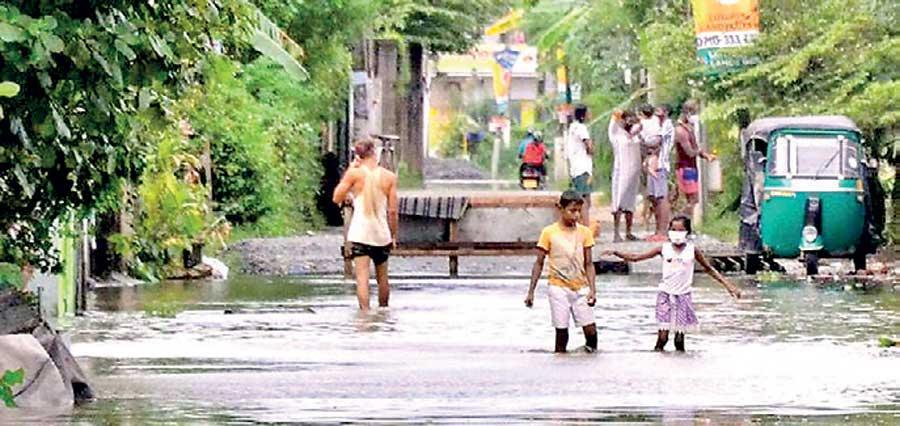Reply To:
Name - Reply Comment
Last Updated : 2024-04-23 20:04:00

The Intergovernmental Panel on Climate Change (IPCC) Sixth Assessment Report, the world’s most authoritative assessment on climate change and associated impacts, was released on August 9, 2021.
assessment on climate change and associated impacts, was released on August 9, 2021.
One of the key areas of this report is the assessment of 33 individual Climate Impact Drivers (CIDs) across 44 sub regions in the world. The report identifies several CIDs that are projected to change with high confidence and would affect climatic changes in the South Asian region by 2050.
“Sri Lanka only has 29 years left to put in place adaptation measures and be prepared for increasing hazards and this is not a lot of time,” said Prof. Roshanka Ranasinghe, AXA Chair in Climate Change Impacts and Coastal Risk at IHE Delft and Head of the Department of Coastal & Urban Risk & Resilience IHE Delft (The Netherlands). He’s the Coordinating Lead Author of the IPCC Report and was also a Contributing Author in the IPCC Special report on Oceans and Cryosphere in a Changing Climate (SROCC), which was released in 2019.
Excerpts :
 Q What are Climate Impact Drivers?
Q What are Climate Impact Drivers?
One of the main advances in this IPCC Report, compared to previous assessment reports, is its regional scale assessment of climate change (in Chapters 10, 11, 12 and Atlas), which is done at an unprecedented level of granularity, employing changes in 33 individual climatic impact-drivers (CIDs) across 44 sub regions of the world. CID is a new term introduced in AR6 and is defined as “physical climate system conditions (e.g., means, events, extremes) that affect an element of society or ecosystems. Depending on system tolerance, CIDs and their changes can be detrimental, beneficial, neutral, or a mixture of each across interacting system elements and regions. CID types include heat and cold, wet and dry, wind, snow and ice, coastal and open ocean”. The term CID was introduced in this report to bring across the message that not all climate change effects are negative, and that a change that is hazardous in one region/sector could be beneficial in another region/sector. For example, global warming will mean that more energy is needed for air conditioning during hot spells in some parts of the world but it will also decrease cold spells in some parts of the world, leading to less energy demand for heating in those regions. Similarly increases in wind could lead to wind damage, but this can also provide more opportunities for wind power generation.
regional scale assessment of climate change (in Chapters 10, 11, 12 and Atlas), which is done at an unprecedented level of granularity, employing changes in 33 individual climatic impact-drivers (CIDs) across 44 sub regions of the world. CID is a new term introduced in AR6 and is defined as “physical climate system conditions (e.g., means, events, extremes) that affect an element of society or ecosystems. Depending on system tolerance, CIDs and their changes can be detrimental, beneficial, neutral, or a mixture of each across interacting system elements and regions. CID types include heat and cold, wet and dry, wind, snow and ice, coastal and open ocean”. The term CID was introduced in this report to bring across the message that not all climate change effects are negative, and that a change that is hazardous in one region/sector could be beneficial in another region/sector. For example, global warming will mean that more energy is needed for air conditioning during hot spells in some parts of the world but it will also decrease cold spells in some parts of the world, leading to less energy demand for heating in those regions. Similarly increases in wind could lead to wind damage, but this can also provide more opportunities for wind power generation.
Q How are CIDs identified?
The approach adopted to identify CIDs is consistent with the United Nations ‘Sendai Framework for Disaster Risk Reduction 2015-2030’, which aims to face disaster consequences (including, but not limited to climate disasters) and reduce risks in natural, managed, and built. The classification of climatic impact-drivers in this chapter is largely consistent with the classification of hazards used in the Sendai Framework. This report assesses climate information relevant for impact and for risk assessment in the seven main sectors:
Terrestrial and freshwater ecosystems and their services;
Ocean and coastal ecosystems and their services;
Water;
Food, fibre and other ecosystem products;
Cities, settlements and key infrastructure;
Health, well-being and the changing structure of communities;
Poverty, livelihoods and sustainable development.
Many of these sectors also include assets affected by climate change that are important for recreation and tourism, including elements of ecosystems services, health and well-being, communities, livelihoods, and sustainable development. CIDs can be captured in seven main types: heat and cold, wet and dry, wind, snow and ice, coastal, oceanic and others.
Q Let’s talk about CIDs that are projected to change with high confidence and how Sri Lanka will be affected if we don’t take precautions immediately.
This report assesses that there is high confidence in the following CIDs changes in South Asia, by 2050: increases in average daily temperature, extreme heat (i.e. heat waves), average rainfall, heavy rainfall and urban floods, average sea level, coastal flooding, coastal erosion, marine heatwaves, and ocean acidity. Importantly, as these are projections for 2050, there is only 29 years left for Sri Lanka (and other countries) to put in place adaptation measures to be prepared for increasing hazards, especially for these CIDs that are projected to change with high confidence. This is not a lot of time as adaptation measures, for e.g. building coastal flood and erosion defenses, requires not only careful planning and design but also financing (millions of dollars). For a developing country like Sri Lanka, finding the financing will take time, and given also the lead time required for design and implementation of measures, we must start acting now to have effective adaptation measures implemented on the ground in 10-12 years. In some coastal areas, cost-benefit analyses might show that a managed retreat may make more sense than protection. But this takes even longer as a lot of community consultations will be needed to help change the mindset of those that are to be displaced and alternative settlements will need to be planned, designed and built. To do this properly, without having to face a public outcry, would take 20-25 years of strategy implementation. Adapting to climate change cannot be avoided, and it cannot be done in a reactive way like we do for natural disasters. This can be seen as a slow onset disaster. Adaptation has to be done carefully and along certain pathways on a continuous basis. Climate adaptation has to be dis-engaged from the 5-6 year political cycles and done by independent experts who stay with the task from start to finish (so for 10-20 years) despite political changes in the country.
Q In what ways should people engaged in industries such as agriculture adapt or be prepared for these changes?
Any large changes in temperature, rainfall and drought occurrence/intensity will directly be translated into on-the-ground impacts on the environment and primary produce of the country, with subsequent dire consequences for the national GDP as well as people’s livelihoods. The core business of the Ministries of Environment, Agriculture and Forestry, will therefore be directly affected by any climate change driven variations in weather patterns in Sri Lanka. Therefore, reliable projections of future climate change driven variations of at least these environmental conditions, would be of immense benefit to GoSL in order to develop effective strategies and policies to mitigate any negative impacts of climate change on the environment and primary production in Sri Lanka.
I think the first thing that needs to be done is a reliable downscaled (i.e. high resolution) climate projection study for Sri Lanka. This is why Global climate models (GCMs), such as those used by the Intergovernmental Panel on Climate Change (IPCC) to produce global scale projections on future climate, have a spatial resolution of about 200 kms near the equator. This is far too coarse to obtain reliable and useful local scale projections of future climate conditions, especially within a small country such as Sri Lanka. For Sri Lanka in particular, as the local weather is very much governed by monsoons, it is important to perform this downscaling to at least 25 km resolution. Previous downscaling studies for Sri Lanka have shown the monsoon signal can just barely be captured at 25 km resolution but is entirely missed at lower resolutions. Thus, dynamic downscaling (using a process based regional scale numerical model with a higher resolution computational grid over the area of interest – in this case Sri Lanka) is an essential first step. As far as I know, there are no organisations within Sri Lanka that has the ability or expertise to setup and run dynamic downscaling models, which is reflected by the non-availability to date of any reliable and robust high resolution climate change projections that are underpinned by high resolution downscaled GCM output for the country.
Q In what aspects are we lacking in terms of climate change research? Is it resources, technology or expertise?
As you have correctly identified, Sri Lanka, as well as many other developing countries, has long suffered from a certain apathy towards climate change. This has led to a lack of knowledge and expertise on this topic in the country. However, over the last few years I have had more and more questions asked from me about climate change impacts by Sri Lankan professionals and media. So I do feel that the interest level is picking up. However, as there is now an urgency for putting in place adaptation measures, I feel the best strategy for the country would be to seek foreign expertise on this topic, which is very very advanced in Europe especially. For example, if the climate secretariat were to work closely with a team of foreign experts, who could also help source financing of adaptation solutions, that would ensure that Sri Lanka is prepared for the intensification of climate related hazards that is projected to occur in the years, decades ahead. The crucial thing here, as climate change is a process that will be ongoing for 100s of years, despite mitigation efforts, is to de-politicise the entire process of climate adaptation. Then only we will be able to build a climate resilient Sri Lanka.
Q How will key findings from this report be applied to minimize anthropogenic impacts on climate change in the coming years?
This report was timed to feed into the COP26 meeting in Nov 2021 which will take place in Glasgow. Countries will commit to their respective greenhouse gas emission reductions over the near and long term at this important meeting. The findings of this report will directly feed into those discussions and help set country level target for emission reductions.
More about COP26 can be
found at https://ukcop26.org/.

Add comment
Comments will be edited (grammar, spelling and slang) and authorized at the discretion of Daily Mirror online. The website also has the right not to publish selected comments.
Reply To:
Name - Reply Comment
On March 26, a couple arriving from Thailand was arrested with 88 live animal
According to villagers from Naula-Moragolla out of 105 families 80 can afford
Is the situation in Sri Lanka so grim that locals harbour hope that they coul
A recent post on social media revealed that three purple-faced langurs near t